
Nestled along the mighty Danube River, Vienna is the capital of Austria and by far its most populous city, serving as the country’s political, economic and cultural heart. Renowned for its classic music, ample coffee culture and sumptuous architecture, the Austrian capital attracts more than 10 million tourists annually. Given this very figure, Vienna’s main attractions are almost always overcrowded with swarms of camera-armed gawkers. Luckily though, there are still a couple of places across the city which persistently retain a shred of authenticity, making them an ideal escape from the otherwise over-commercialized scenery.
For the untrained eye, the oddly-looking edifice near the Donaukanal water channel might seem like a museum for contemporary art. Nevertheless, looks can be deceiving as this ultra-decorated structure is in fact an incineration plant. Originally built in the early 1970’s, the Spittelau Incinerator converted a significant portion of Vienna’s household waste into a useable energy, killing two birds with one stone.
That all came into an abrupt end in 1987, when fire spread rapidly throughout the premises, and in a matter of minutes the entire facility was ablaze. However, instead of demolishing the heavily-damaged building, authorities opted to reconstruct it a year later. Determined to catch the opportunity and transformed the site to far more than just a power-generating plant, city officials tasked Vienna-born architect and artist Friedensreich Hundertwasser with designing the new building.
Acclaimed for his whimsical style, Hundertwasser decorated the waste incinerator with a series of murals throughout the façade and an oversized golden ball hanging around the chimney. Perhaps his most exceptional decision, though, was to place a gilded cap atop the roof. Story has it that this element was inspired by a remark of him “Ich hau den Hut drauf” (roughly translated to I’m throwing a hat on top) during a meeting with the project manager.
Be that as it may, as of today, the power plant incinerates more than 250,000 tons of waste every year, producing electricity for 50,000 houses as well as warm water for additional 60,000 Viennese households.
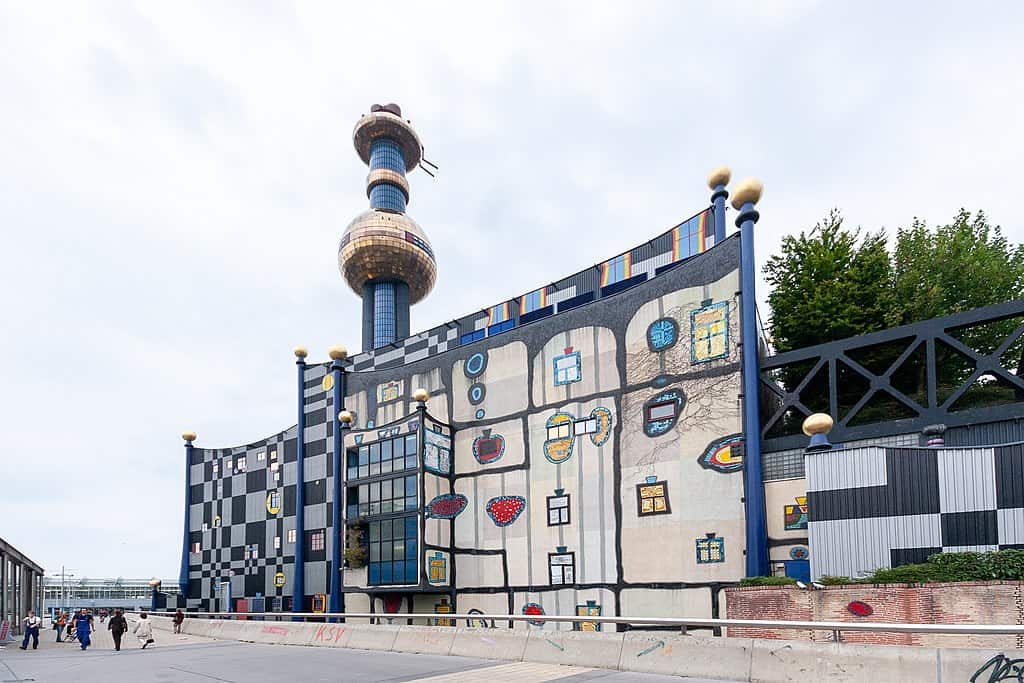
The vividly painted frontage and ornate chimney of Spittelau plant building
photography by: Dimitry Anikin/ Wikimedia Commons
According to most, if not all, demographic statistics, the world’s smallest and least-populous country is the Vatican City in Rome. That is, unless you are talking about Kugelmugel, a self-proclaimed state that stretches across a single, small-sized building, well-ensconced in Vienna’s 2nd District.
This ultra-eccentric project was born in 1971, when Edwin Lipburger, an artist from the town of Katzelsdorf in Lower Austria erected a globe-shaped building in his backyard. Made of lumber planks with zinc cladding, the structure was initially used as Lipburger’s studio and workshop. As the wooden ball lacked any building permits, Lipburger soon found himself in a legal battle with the local authorities.
As a last resort to save his atelier from demolition, he peppered the surrounding grounds with street signs, ultimately declaring the place as a sovereign nation, better-known as the Republic of Kugelmugel (“spherical hill” in German). The newly-created micronation had a rough start as its leader, Lipburger, was sent to jail for more than two months for violating several building codes.
In the aftermath of Lipburger’s jailtime, his breakaway country was offered a fresh beginning in Vienna by the city councilor Helmut Zilk, who promised that Kugelmugel would receive all of the necessary infrastructure it needs. Soon thereafter, the spherical structure was relocated to Prater amusement park, where it has been encircled by a barbed wire fence for over 4 decades.
While Lipburger passed away a few years ago, his pint-sized republic has so far withstood the test of time, boasting about 600 non-resident citizens.

Kugelmugel’s sphere-shaped structure in Prater Park
photography by: Peter Gugerell/ Wikimedia Commons
You would be forgiven for mistaking the cluster of pillars and arches near Liechtenstein Castle with the ruins of an ancient Roman amphitheater, but as it turns out, there is more to this than meets the eye.
Tucked away in the southern outskirts of Vienna, in the town of Maria Enzersdorf, Liechtenstein Castle is a hilltop fortress whose history goes all the way back to the 12th century. Perching atop a rocky outcrop, the castle owes its name to the light hue of the crag on which it sits (Liechtenstein – “bright stone” in German). Hugo von Petronell, the man who originally built the citadel, later adopted the moniker, becoming the progenitor of the House of Liechtenstein, who still owns the complex (as well as the tiny alpine principality).
Throughout the centuries, the castle along with its precinct was destroyed twice by the Ottoman army, first in the 1529’s siege of Vienna, and then in 1683 during the Battle of Vienna. It wasn’t until the 19th century when the fortress was restored to its former glory.
Interestingly though, as part of the massive renovation works, a replica of a Roman theater was erected on the nearby wooded hillside. Designed in 1810 by architect Joseph Hardtmuth, the site pays homage to Ancient Rome with a pair of 2 story towers alongside a series of 16 arches, all of which are beautifully decorated with Doric columns.
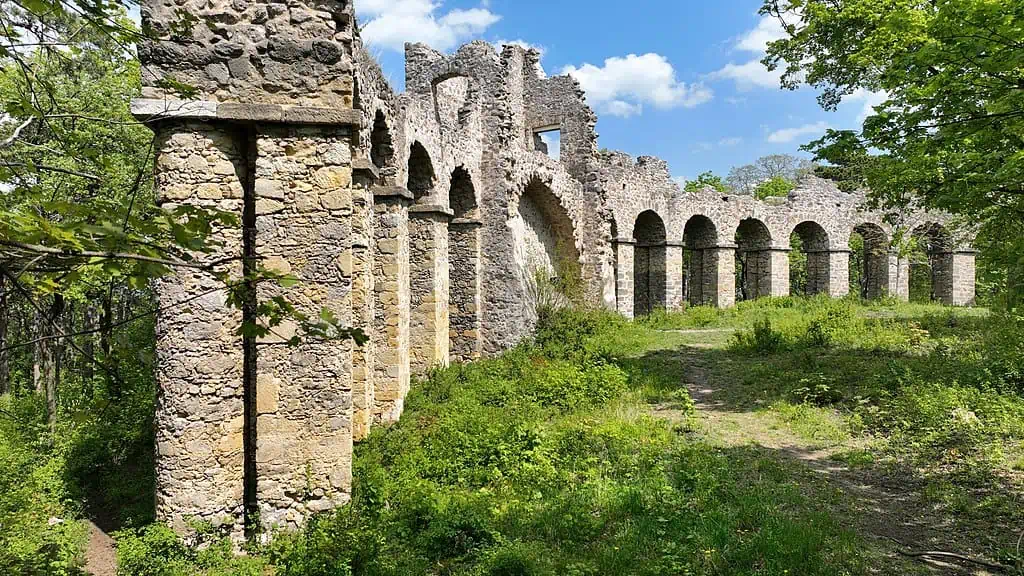
Lying amid the woods, Liechtenstein Castle’s Roman-style Amphitheater
photography by: C.Stadler/Bwag/ Wikimedia Commons
In 1942, at the height of World War II, Nazi-led Germany built a series of six flak towers across the historic center of Vienna as a defensive measure against airstrikes by the Allies. The 6 military structures were divided into three pairs, comprised a combat tower (Gefechtsturm) with an anti-aircraft battery and a lead tower (Leitturm), home to a command center and a bunker.
The largest of these WW2 relics are now nestled amid the verdant lawns of Arenbergpark, where they serve as a sober reminder for the horrors of the war. The brainchild of architect Friedrich Tamms, these concrete monsters are roughly 40 meter tall, featuring 2.5-meter-thick outer walls and a 4-meter-thick ceiling.
Following the Nazi defeat in 1945, there were several attempts to repurpose the structures as a hospital, a data storage facility and even as a recreational complex, yet none have ever come into fruition. Since 1992, the Leitturm’s ground floor has been used as a warehouse by the municipality’s department of gardening.
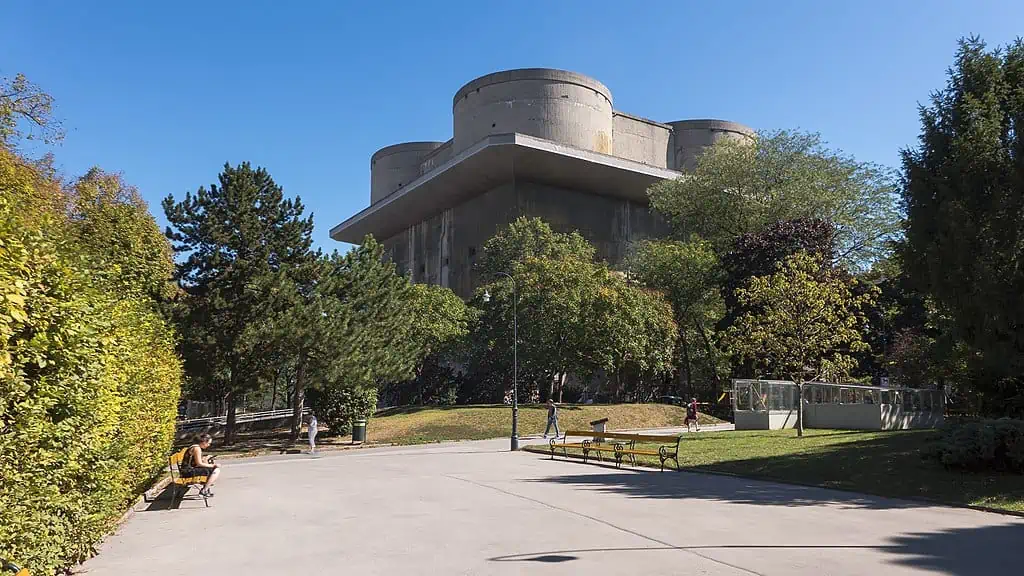
Arenbergpark’s Leitturm
photography by: Gugerell/ Wikimedia Commons
In the brief period between the two world wars (1918 – 1934), the Austrian capital was aptly nicknamed “Red Vienna” for being a socialist stronghold. Led by the Social Democratic Workers’ Party of Austria (SDAP), the city embarked on several public housing projects, with the largest of them being Karl-Marx-Hof in the 19th district of Vienna.
Erected in the late 1920’s over a land which was previously well under the surface of the Daunbe River, Karl-Marx-Hof was home to more than 1,300 apartments, scattered across a 1,100-meter-long edifice, making it among the world’s longest residential buildings. While the complex spans over an area of 15.6 hectares, less than a fifth of it is actually built, covered instead with multiple interconnected gardens and plazas. If one wishes to grasp the full extent of this mega-structure, it is enough to look at the estimated number of used bricks – a whopping 24 million.
Planned as a self-sufficient community, this mind-bogglingly long building also has a couple of kindergartens, self-service laundromats, public baths, a library and even an office space for doctors and businesses.
During the Austrian Civil War in 1934, the large residential complex served as a refuge for dozens of left-leaning militants. That in turn quickly escalated into a full-blown battle that ravaged the place and ended with the full surrender of the socialist armed group. In recent years, the gargantuan apartment block came to the spotlight under far more peaceful circumstances – a filming location for movies.
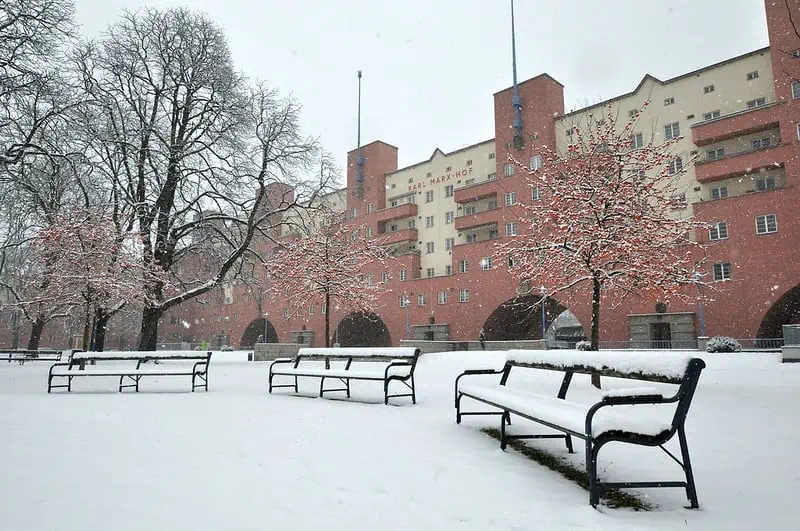
The residential complex during wintertime
photography by: Herbert Frank/ Flickr
An effective mean to surmount a steep topography, outdoor stairways offer a pedestrian shortcut in many cities across the world, including Vienna. In stark contrast to its purely utilitarian counterparts, the beautifully decorated Strudlhofstiege staircase in Alsergrund district boasts a cultural and historical merit that makes it far more than just an unassuming passage.
In the late 17th century, Austrian sculptor and painter Peter Strudel arrived from Cles in northern Italy to Vienna, where he established the Strudlhof painting school. Situated atop a hilly terrain, the school operated until Strudel’s death in 1714. With its founder gone, all courses were abruptly ceased and the school building was subsequently demolished.
For nearly two centuries or so, a large portion of the site where the arts school formerly stood was the dead-end of Strudlhofgasse Street. It all changed in 1910, when the cul-de-sac along with the adjacent slope were replaced with a brand-new staircase, meticulously designed by architect Theodor Johann Jaeger.
Built using Mannersdorf limestone, the ornate steps consist of a symmetrical flight of stairs, decorated with a pair of gargoyle-featured fountains, followed by an asymmetrical stairway with metal railings and light poles. The Art Nouveau-style staircase famously inspired the novel “Die Strudlhofstiege oder Melzer und die Tiefe der Jahre” by author Heimito von Doderer, who portrayed the iconic steps as a central location in multiple scenes throughout his book.
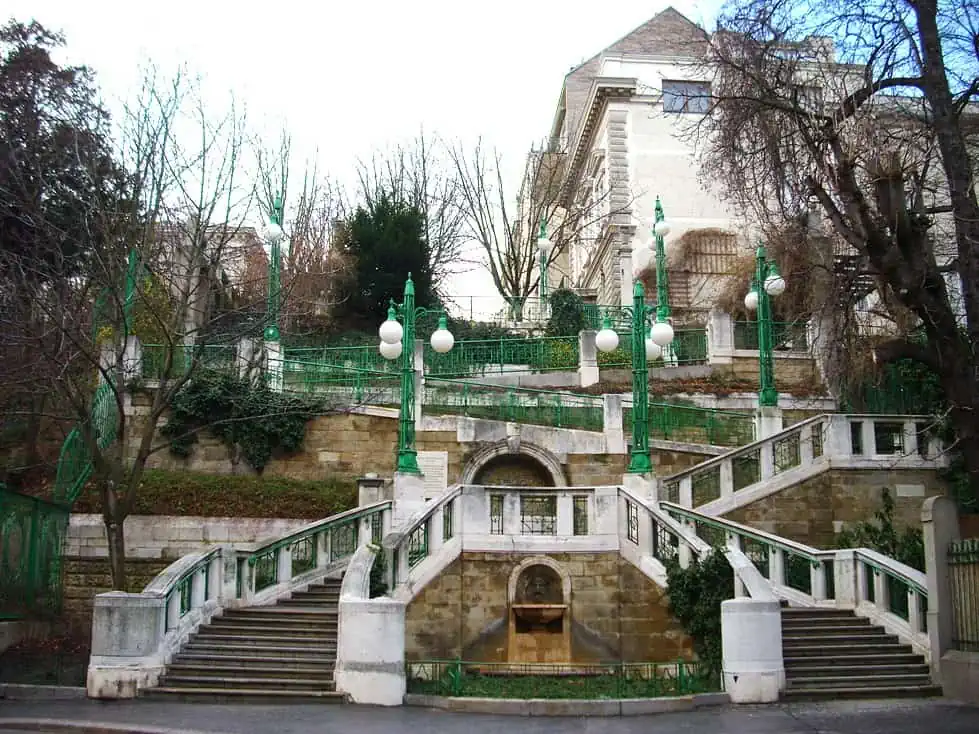
Strudlhof Steps, as viewed from Pasteurgasse Street
photography by: Ernst Raser/ Flickr
Ensconced in a mid-forest glade on the western outskirts of the Austrian capital, the Jubilee Tower (Jubiläumswarte) is an oddly-shaped observatory whose viewing platform offers sweeping views of the city’s rural and natural surroundings.
The tower was originally constructed in 1898 as a wooden structure, marking the 50th anniversary of the reign of the Emperor of Austria, Franz Joseph I, hence its name – the Jubilee Tower. Its days of glory, however, were short lived as less than a year after its inauguration, the watchtower collapsed during a storm. A couple of months down the line, a 27.5-meter-tall iron-made tower was erected at the same location, replacing its feeble predecessor.
While the second attempt was far more successful and lengthier, it too failed to pass the test of time as the tower was forced to close its doors in 1952 due to a wide-scale corrosion, and was demolished soon thereafter. Four years later, a third observation tower was built in the exact spot where the former two once stood.
Featuring a 183-step spiral staircase that wraps around a cylindrical structure, the tower is merely 31 meter tall, but what it lacks in total height, it makes up for in elevation. Situated 480 meters above sea level, the tower’s viewing deck offers a distant glimpse of Vienna as well as spectacular vistas of the Austrian countryside.

The Jubilee Tower and its spiral staircase
photography by: C.Stadler/Bwag and Robot8A/ Wikimedia Commons
For centuries on end, the town of Laxenburg, about 15 kilometers south of downtown Vienna, was routinely frequented by members of Austria’s imperial dynasties. With several lavishly designed castles and plenty of greenery, the place became a popular summer retreat for Vienna’s upper echelons of society.
During the late 18th century, the town was increasingly experiencing seasonal floods. To mitigate this very problem, Emperor Franz I commissioned the creation of an expansive reservoir that would catch the excess water. Spanning across 25 hectares, the lake also included a couple of artificial islands, one of which is where the medieval-style castle of Franzensburg was built in the 1830’s.
To make this massive engineering fit possible, a 1.7-kilometer-long waterway known as the Forstmeisterkanal was excavated throughout the nearby fields, thus connecting the reservoir with the region’s canal system. Straddles the waterway is a structure comprising both a weir and a bridge. Surrounded by a verdant woodland, the Forester Bridge forms an artificial waterfall, which in spite of its small size, still bears a resemblance to a naturally formed cascade. Overlooking the waterfall is a pair of sculpted female sphinxes, in what seems like a gesture to Ancient Egypt, China and Western Feminism all together.

One of two female sphinxes that perches atop the weir
photography by: Anna Saini/ Wikimedia Commons